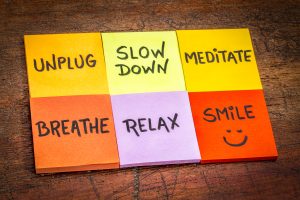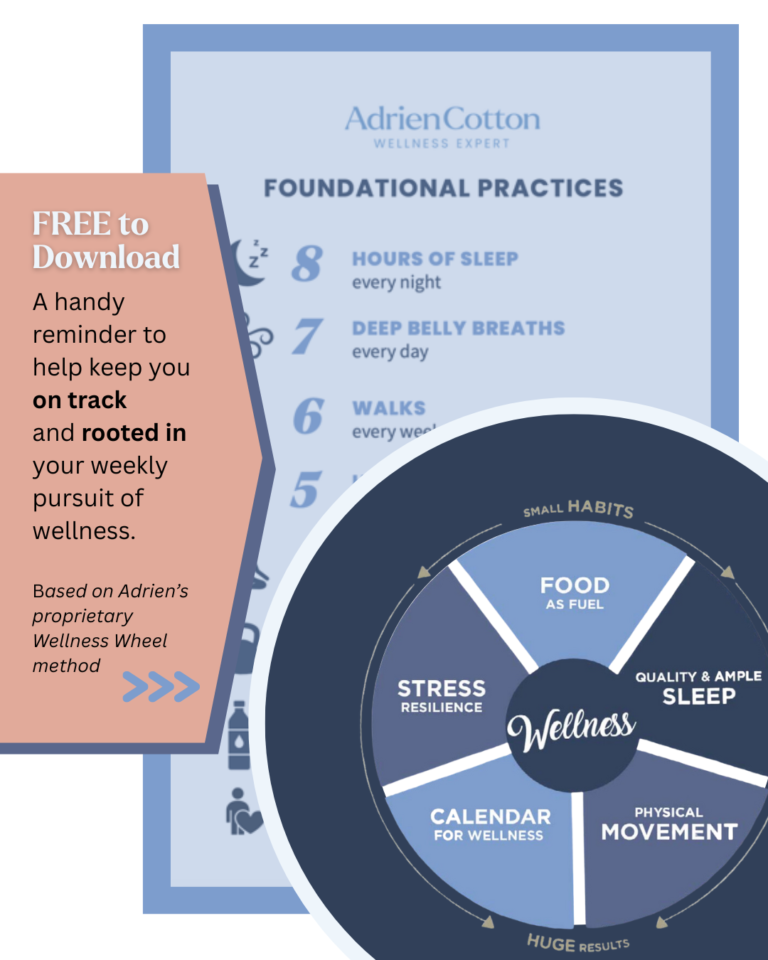Midlife is often a time of increased stress for women. The demands of work, the combined needs of caregiving for children and aging parents, and the pressure of keeping up with a demanding schedule can leave us feeling exhausted by lunchtime. Add in the hormonal changes our bodies experience during the menopausal transition, and many find themselves in a perfect storm of endlessly stressful days.

I’ve been there too – raising twin toddlers and running my own business; attempting to squeeze in self-care on little sleep; feeling constantly overwhelmed; and doing it all while in the throes of perimenopause. I reached a point where the stress became too much, and I could no longer keep up my frenetic pace. I knew it was time to change my approach to stress and prioritize my mental and physical wellness.
There are two types of stress. The first is eustress which is the feel-good type of stress that occurs in response to positive events and increases our motivation and creativity. The second, distress, inhibits productivity and wellness and causes both mental and physical strain.
Stress is more than a feeling, it is physiological and can create a multitude of health issues. Stress can raise blood pressure and increase hypertension. It can cause muscle tension throughout the body, most notably in the shoulders and neck, exacerbating headaches and migraines. It can also lower our immune system, making us more susceptible to colds or that bug going around the office or the kids’ school.
Most importantly, it can disrupt our sleep and hinder our decision-making. When we’re tired, we often don’t make the healthiest decisions for ourselves, instead taking the path of least resistance…we choose the donut instead of the protein-packed snack that will fuel our bodies.
Chronic stress can be even more detrimental to our health. Prolonged stress can raise our levels of adrenaline and cortisol. It can also increase our cholesterol levels which, in turn, raises our blood pressure and the chances of experiencing hypertension, a heart attack, or a stroke.
A report by the American Psychological Association noted that the sustained levels of estrogen in premenopausal women appear to help their blood vessels sustain some level of protection against chronic stress and the possibility of heart disease. However, as postmenopausal women experience a drop in estrogen, they lose that circulatory resilience, putting them at greater risk for heart disease due to stress.
So, what can we do to help manage our stress levels during midlife and menopause?
One simple and effective method uses our breath.
A sure sign we are under stress is when our breathing gets stuck in our upper chest instead of filling the belly. These short, shallow breaths cause the diaphragm to be underutilized and prevent our lungs from receiving fully oxygenated air.

A full exchange of air occurs when our body swaps incoming oxygen for outgoing carbon dioxide. With shallow breathing, our oxygen and carbon dioxide levels can become imbalanced, causing us to feel dizzy, an increase in our heart rate, and a buildup of tension throughout our body. Having too much carbon dioxide in the blood can also cause a stress response that contributes to anxiety and panic attacks.
This stress response, known as fight or flight mode, is controlled by our sympathetic nervous system. When it is activated, we can feel our heart pounding and a rush of adrenaline. The need for our bodies to respond quickly to stress was super helpful thousands of years ago when we may have had to outrun a lion, but in today’s modern society where lions aren’t the norm, this flood of adrenaline is misplaced and can bring on bouts of anxiety instead.
To reduce this shortness of breath and manage the resultant anxiety, practice measured, deep-belly or diaphragmatic breathing. Breathing deep into the abdomen fully utilizes the diaphragm and encourages the proper exchange of oxygen and carbon dioxide. When we are more conscious of the flow of our breath, we can lower our blood pressure, awaken the parasympathetic system (also known as rest and digest mode), and have more control of our stress response.
Finding calm during stress and anxiety can be as simple as taking 30 seconds to focus solely on your breath. When stress gets the better of you, take a moment to notice your breath, how it moves throughout your body, and its pace and flow. The more we draw the breath into the belly as we breathe, the more relaxed we will feel.
Another effective breath practice is called box breathing. This sequence is great for trying to move the breath more toward the belly.
- Inhale for four counts.
- Hold the breath for four counts.
- Exhale for four counts.
- Hold the breath for four counts.
- Repeat the sequence for five rounds or until the body begins to relax.
I also recommend the benefits of rhythmic breathing. I find this practice to be instantly calming.
- Inhale for four counts.
- Hold the breath for two counts.
- Release the breath slowly for 8 counts, either through the nose or through pursed lips to regulate the flow of the exhale.
- Pause for two counts.
- Repeat as many times as necessary.
Finally, one of my favorite practices is this visualized breathing exercise that is perfect before sleep or first thing in the morning. You can practice this type of breathing for a few to several minutes, and I find it works best lying down.
- Close your eyes and place the left hand on the upper chest and the right hand on the belly to feel the movement of the breath through the torso.
- Without changing its movement, observe your inhale and notice how it moves through your body. Does the inhale inflate the belly? Does it feel stuck in the chest?
- Observe your exhale. Does it initiate from the belly and then move through the chest and out through the mouth? Does the exhale provide a sense of release?
- With the next breath, let it flow in and out without commentary; simply notice its movement.
- If you find your mind wandering, it can help to say to yourself “breathing in” and “breathing out” with each inhale and exhale. This helps keep your awareness in the present moment.
- Once you’ve completed your practice time (a timer can be helpful here), take a few moments to bring your attention back to the room and your surroundings before gently opening your eyes.
The next time you notice a stressful situation brewing, give one of these breathing exercises a try. And remember, the best time to improve our stress response is before we’re in the middle of it! Committing to a morning belly breathing practice helps me feel refreshed and more calm and ready to tackle my day. At night, it helps prepare my body for sleep and gives me time to redirect my focus from the busyness of the day to the comfort of my bed.
Often, many of us cannot identify what is the cause of our stress. Through my Concierge Small Group Wellness and MASTER Menopause NOW! programs, I teach you how to identify stress triggers, pinpoint when and how stress affects your overall health and wellness, and how to add stress resilience practices to your daily life. Join us and learn how mastering stress is one of the foundational keys to mastering menopause.



